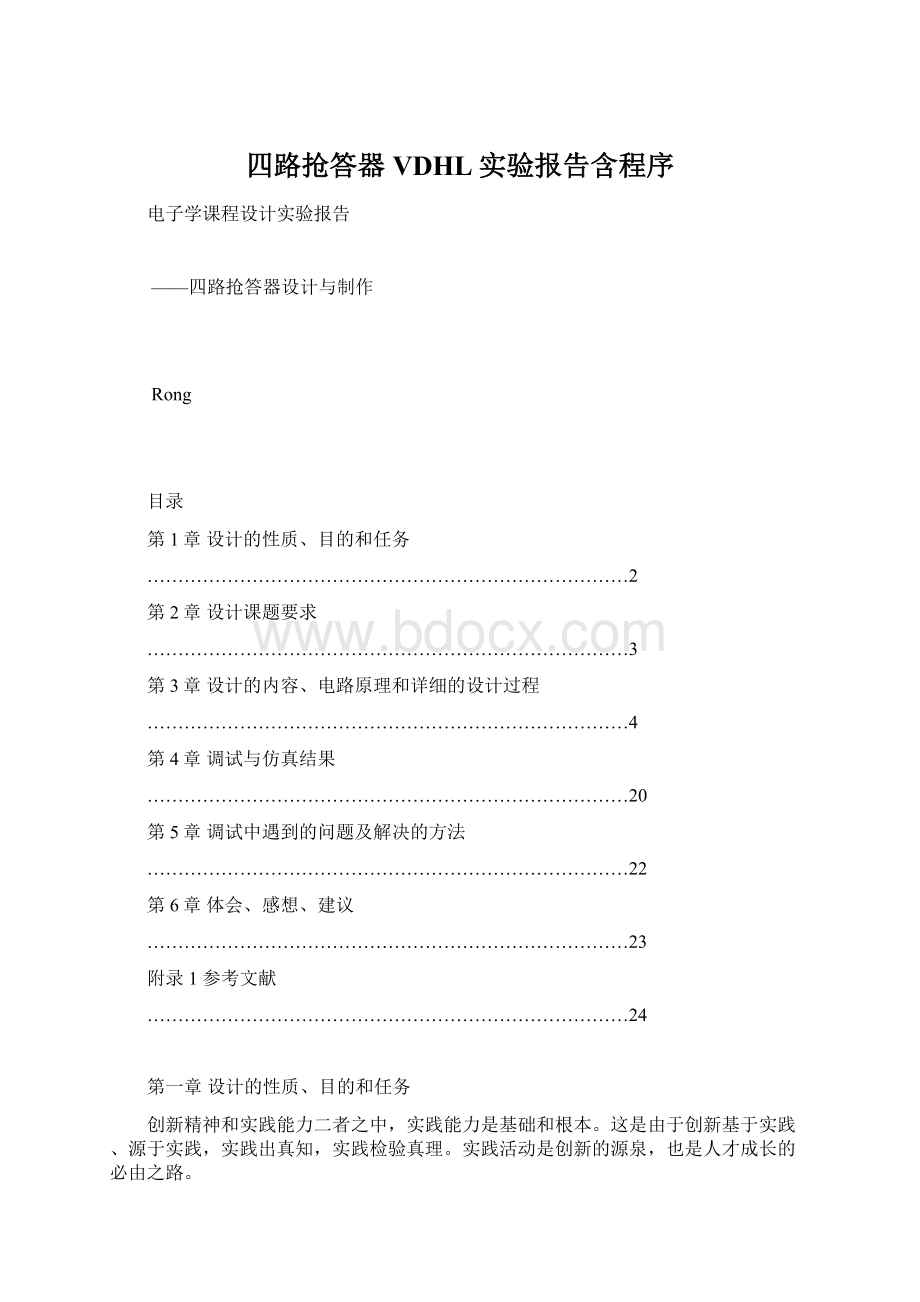四路抢答器VDHL实验报告含程序.docx
《四路抢答器VDHL实验报告含程序.docx》由会员分享,可在线阅读,更多相关《四路抢答器VDHL实验报告含程序.docx(25页珍藏版)》请在冰豆网上搜索。

四路抢答器VDHL实验报告含程序
电子学课程设计实验报告
——四路抢答器设计与制作
Rong
目录
第1章设计的性质、目的和任务
……………………………………………………………………2
第2章设计课题要求
……………………………………………………………………3
第3章设计的内容、电路原理和详细的设计过程
……………………………………………………………………4
第4章调试与仿真结果
……………………………………………………………………20
第5章调试中遇到的问题及解决的方法
……………………………………………………………………22
第6章体会、感想、建议
……………………………………………………………………23
附录1参考文献
……………………………………………………………………24
第一章设计的性质、目的和任务
创新精神和实践能力二者之中,实践能力是基础和根本。
这是由于创新基于实践、源于实践,实践出真知,实践检验真理。
实践活动是创新的源泉,也是人才成长的必由之路。
通过课程设计的锻炼,要求学生掌握电路的一般设计方法,具备初步的独立设计能力,提高综合运用所学的理论知识独立分析和解决问题的能力,培养学生的创新精神。
第二章设计课题要求
四路抢答器设计与制作
设计要求:
设计一个四路抢答器。
抢答器必须具有互锁功能,同时抢答时每次只能有一个输出有效。
同时,抢答时具有计时功能,限定选手的答题时间,在接近规定时间时进行提示,达到规定时间发出终止音。
主持人可控制加分或减分。
见简略示意图。
第三章设计的内容、电路原理和详细的设计过程
3.1设计内容
3.1.1流程图
YESNO
YES
NO
YES
NO
图1流程图
3.1.2设计思路
自顶向下,顶层采用原理图设计,以下各层次采取VHDL描述语言实现。
顶层用原理图简单,方便。
模块用VHDL,可读性好,移植性好,入档、交流、交付方便。
模块须分为以下模块:
抢答鉴别电路,计时器,记分器,分频器,扫描显示,译码器,蜂鸣器。
3.2电路原理
图2四路抢答器的组成
3.3详细的设计过程
3.3.1顶层设计
按图2设计。
如果模块需要增减再进行修改。
3.3.2抢答鉴别电路设计
I.输入/输出:
4个按键抢答输入:
a,b,c,d;
4个接LED的输出a1,b1,c1,d1;
1组给记分器的片选输出states[3..0]。
II.功能:
先输入a时,a1输出,b,c,d不能输入;
先输入b时,b1输出,a,c,d不能输入;
先输入c时,c1输出,a,b,d不能输入;
先输入d时,d1输出,a,b,c不能输入;
片选给记分器选择结果。
III.VHDL程序:
libraryieee;
useieee.std_logic_1164.all;
entityqdjbis
port(a,b,c,d:
instd_logic;
a1,b1,c1,d1:
outstd_logic;
states:
outstd_logic_vector(3downto0));
endentityqdjb;
architectureartofqdjbis
constantw1:
std_logic_vector:
="0001";
constantw2:
std_logic_vector:
="0010";
constantw3:
std_logic_vector:
="0100";
constantw4:
std_logic_vector:
="1000";
begin
process(a,b,c,d)is
begin
if(a='1'andb='1'andc='1'andd='1')then
a1<='0';b1<='0';c1<='0';d1<='0';states<="0000";
elsif(a='0'andb='1'andc='1'andd='1')then
a1<='1';b1<='0';c1<='0';d1<='0';states<=w1;
elsif(a='1'andb='0'andc='1'andd='1')then
a1<='0';b1<='1';c1<='0';d1<='0';states<=w2;
elsif(a='1'andb='1'andc='0'andd='1')then
a1<='0';b1<='0';c1<='1';d1<='0';states<=w3;
elsif(a='1'andb='1'andc='1'andd='0')then
a1<='0';b1<='0';c1<='0';d1<='1';states<=w4;
endif;
endprocess;
endarchitectureart;
IV.模块图形:
图3抢答鉴别电路
3.3.3计时器设计
I.输入/输出:
1个时钟信号输入
1个复位信号输入
2组4位2进制信号输出作为显示计时信号。
II.功能:
通过1Hz的时钟进行20秒倒计时,至00停止直至复位信号给入,恢复20。
III.VHDL程序:
libraryieee;
useieee.std_logic_1164.all;
useieee.std_logic_unsigned.all;
entityjsqis
port(clk,clr:
instd_logic;
qa:
outstd_logic_vector(3downto0);
qb:
outstd_logic_vector(3downto0));
endentityjsq;
architectureartofjsqis
begin
process(clk,clr)is
variabletmpa:
std_logic_vector(3downto0);
variabletmpb:
std_logic_vector(3downto0);
begin
ifclr='0'thentmpa:
="0000";tmpb:
="0010";
elsifclk'eventandclk='1'then
iftmpa="0000"andtmpb="0000"then
tmpa:
="0000";
tmpb:
="0000";
elsiftmpa="0000"then
tmpa:
="1001";
iftmpb="0000"thentmpb:
="0010";
elsetmpb:
=tmpb-1;
endif;
elsetmpa:
=tmpa-1;
endif;
endif;
qa<=tmpa;qb<=tmpb;
endprocess;
endarchitectureart;
IV.模块图形:
图4计时器
3.3.4记分器设计
I.输入/输出:
1个时钟信号输入;
1个复位信号输入;
1组片选信号输入;
4组4位2进制输出作为分数信号;
II.功能:
在时钟上升沿,依照片选信号,通过add(min)信号进行加(减)1分操作。
结果分别通过aa1,bb1,cc1,dd1反映。
III.VHDL程序:
--jifenqi
libraryieee;
useieee.std_logic_1164.all;
useieee.std_logic_unsigned.all;
entityjfqis
port(rst:
instd_logic;
clk:
instd_logic;
add:
instd_logic;
min:
instd_logic;
chos:
instd_logic_vector(3downto0);
aa1,bb1:
outstd_logic_vector(3downto0);
cc1,dd1:
outstd_logic_vector(3downto0));
endentityjfq;
architectureartofjfqis
begin
process(rst,add,min,chos)is
variablepoints_a1:
std_logic_vector(3downto0);
variablepoints_b1:
std_logic_vector(3downto0);
variablepoints_c1:
std_logic_vector(3downto0);
variablepoints_d1:
std_logic_vector(3downto0);
begin
if(clk'eventandclk='0')then
ifrst='0'then
points_a1:
="0000";
points_b1:
="0000";
points_c1:
="0000";
points_d1:
="0000";
endif;
ifadd='0'then
ifchos="0001"then
ifpoints_a1="1001"then
points_a1:
="0000";
else
points_a1:
=points_a1+'1';
endif;
elsifchos="0010"then
ifpoints_b1="1001"then
points_b1:
="0000";
else
points_b1:
=points_b1+'1';
endif;
elsifchos="0100"then
ifpoints_c1="1001"then
points_c1:
="0000";
else
points_c1:
=points_c1+'1';
endif;
elsifchos="1000"then
ifpoints_d1="1001"then
points_d1:
="0000";
else
points_d1:
=points_d1+'1';
endif;
endif;
elsifmin='0'then
ifchos="0001"then
ifpoints_a1="0000"then
points_a1:
="1001";
else
points_a1:
=points_a1-'1';
endif;
elsifchos="0010"then
ifpoints_b1="0000"then
points_b1:
="1001";
else
points_b1:
=points_b1-'1';
endif;
elsifchos="0100"then
ifpoints_c1="0000"then
points_c1:
="1001";
else
points_c1:
=points_c1-'1';
endif;
elsifchos="1000"then
ifpoints_d1="0000"then
points_d1:
="1001";
else
points_d1:
=points_d1-'1';
endif;
endif;
endif;
endif;
aa1<=points_a1;
bb1<=points_b1;
cc1<=points_c1;
dd1<=points_d1;
endprocess;
endarchitectureart;
IV.模块图形:
图5记分器
3.3.5分频器设计
I.输入/输出:
1个50MHz时钟信号输入;
1个1Hz时钟信号输出;
1个1KHz时钟信号输出;
1个2KHz时钟信号输出。
II.功能:
将50MHz时钟分频为1Hz,1KHz,2KHz分别输出。
III.VHDL程序:
libraryieee;
useieee.std_logic_1164.all;
entityfpis
port(
clk:
instd_logic;
clk1hz,clk1khz,clk2khz:
outstd_logic);
endfp;
architecturebehoffpis
signaldata1khz,data1hz,data2khz:
std_logic:
='0';
begin
clk1hz<=data1hz;
clk1khz<=data1khz;
clk2khz<=data2khz;
clk1khz_pro:
process(clk)--1khz
variablecnt:
integerrange0to24999;
begin
ifclk'eventandclk='1'then
ifcnt=24999then
cnt:
=0;data1khz<=notdata1khz;
else
cnt:
=cnt+1;
endif;
endif;
endprocessclk1khz_pro;
clk1hz_pro:
process(data1khz)--1hz
variablecnt:
integerrange0to499;
begin
ifdata1khz'eventanddata1khz='1'then
ifcnt=499then
cnt:
=0;data1hz<=notdata1hz;
else
cnt:
=cnt+1;
endif;
endif;
endprocessclk1hz_pro;
clk2khz_pro:
process(clk)--2khz
variablecnt:
integerrange0to12499;
begin
ifclk'eventandclk='1'then
ifcnt=12499then
cnt:
=0;data2khz<=notdata2khz;
else
cnt:
=cnt+1;
endif;
endif;
endprocessclk2khz_pro;
endbeh;
IV.模块图形:
图6分频器
3.3.6扫描显示设计
I.输入/输出:
1个时钟信号输入;
6组4位2进制信号输入;
1组位选信号输出;
1组4位2进制信号输出。
II.功能:
通过比人眼识别力频率高的时钟信号,将6组信号在6位上扫描输出,2位固定输出。
III.VHDL程序:
libraryieee;
useieee.std_logic_1164.all;
entityscanis
port(
clk1khz:
instd_logic;
fsd,fsc,fsb,fsa,djs0,djs1:
instd_logic_vector(3downto0);
en_out:
outstd_logic_vector(7downto0);
dataout:
outstd_logic_vector(3downto0));
endscan;
architecturebehofscanis
signalcnt:
integerrange0to7;
signalen:
std_logic_vector(7downto0);
begin
cnt_pro:
process(clk1khz)
begin
ifclk1khz'eventandclk1khz='1'then
ifcnt=7then
cnt<=0;
else
cnt<=cnt+1;
endif;
endif;
endprocesscnt_pro;
scan_pro:
process(cnt,fsd,fsc,fsb,fsa,djs0,djs1)
begin
casecntis
when0=>dataout<=fsd;en<="11111110";
when1=>dataout<=fsc;en<="11111101";
when2=>dataout<=fsb;en<="11111011";
when3=>dataout<=fsa;en<="11110111";
when4=>dataout<=djs0;en<="01111111";
when5=>dataout<=djs1;en<="10111111";
when6=>dataout<="1010";en<="11101111";
when7=>dataout<="1010";en<="11011111";
whenothers=>null;
endcase;
endprocessscan_pro;
en_out<=en;
endarchitecturebeh;
IV.模块图形:
图7扫描显示
3.3.7译码器设计
I.输入/输出:
1组4位2进制输入;
1组8位2进制输出。
II.功能:
将4位2进制输入译码为8位2进制方便八段数码管显示。
III.VHDL程序:
libraryieee;
useieee.std_logic_1164.all;
entitydisplayis
port(
datain:
instd_logic_vector(3downto0);
dataout:
outstd_logic_vector(7downto0));
enddisplay;
architecturebehofdisplayis
begin
process(datain)
begin
casedatainis
when"0000"=>dataout<="11000000";--dp,g,f,e,d,c,b,a
when"0001"=>dataout<="11111001";
when"0010"=>dataout<="10100100";
when"0011"=>dataout<="10110000";
when"0100"=>dataout<="10011001";
when"0101"=>dataout<="10010010";
when"0110"=>dataout<="10000010";
when"0111"=>dataout<="11111000";
when"1000"=>dataout<="10000000";
when"1001"=>dataout<="10010000";
when"1010"=>dataout<="10111111";
when"1011"=>dataout<="10000011";
when"1100"=>dataout<="10100111";
when"1101"=>dataout<="10100001";
when"1110"=>dataout<="10000110";
when"1111"=>dataout<="10001110";
whenothers=>null;
endcase;
endprocess;
endbeh;
IV.模块图形:
图8译码器
3.3.8蜂鸣器设计
I.输入/输出:
2个不同频率时钟信号输入;
2组4位2进制片选信号输入;
1个时钟信号输出。
II.功能:
倒计时2、4、6秒时输出提示音;0秒时输出终止音。
III.VHDL程序:
libraryieee;
useieee.std_logic_1164.all;
useieee.std_logic_unsigned.all;
entitytsyis
port
(clk:
instd_logic;--zhongzhi
clk1:
instd_logic;--tishi
clk_out:
outstd_logic;
qa:
instd_logic_vector(3downto0);
qb:
instd_logic_vector(3downto0));
endentitytsy;
architecturebehaveoftsyis
begin
process(clk,qa,qb)is
begin
ifclk'eventandclk='1'then
if(qa="0000"andqb="0000")then
clk_out<=clk;
elsif(qa="0100"andqb="0000")then
clk_out<=clk1;
elsif(qa="0010"andqb="0000")then
clk_out<=clk1;
elsif(qa="0110"andqb="0000")then
clk_out<=clk1;
elseclk_out<='0';
endif;
endif;
endprocess;
endarchitecturebehave;
IV.模块图形:
图9蜂鸣器
第四章调试与仿真结果
4.1抢答鉴别电路
图10抢答鉴别电路仿真时序图
4.2计时器
图11计时器仿真时序图
4.3记分器
图12记分器仿真时序图
4.4分频器
图13分频器仿真时序图
4.5扫描显示
图14扫描显示仿真时序图
4.6译码器
图15译码器仿真时序图
4.7蜂鸣器
图16蜂鸣器仿真时序图
第五章调试中遇到的问题及解决的方法
5.1问题1:
按键无反应。
解决方法:
赋值高低电平给反了,把=’1’改为=’0’即可。
5.2问题2:
process中add’eventandadd=’1’ormin’eventandmin=’1’无法编译。
解决方法:
process中只能出现一个变化沿,用clk’eventandclk=’1’代替,再进行选择即可。
5.3问题3:
数码管显示乱码。
解决方法:
数码管位选与段选引脚接反,重新按正确接法分配引脚即可。
5.4问题4:
20s计时器到0后变为29。